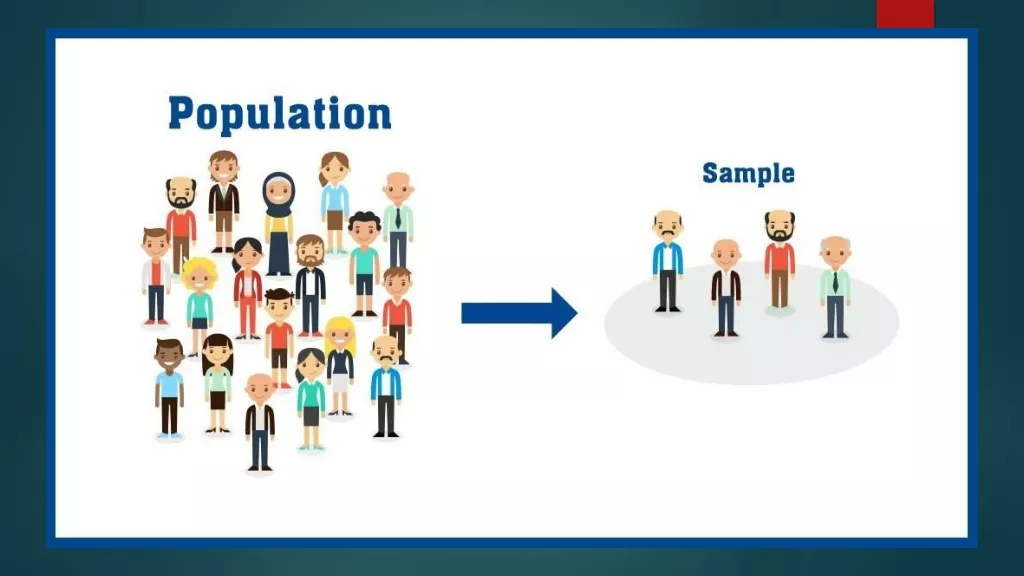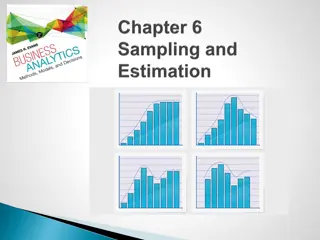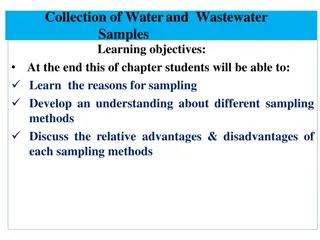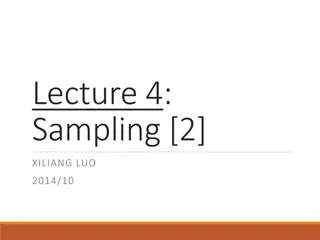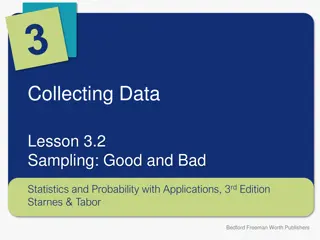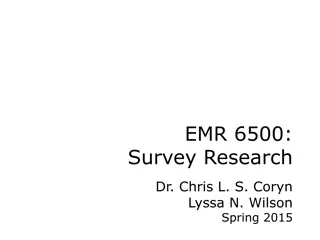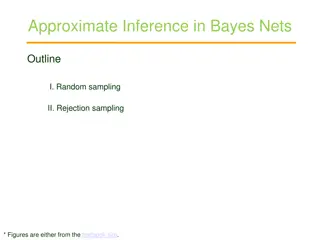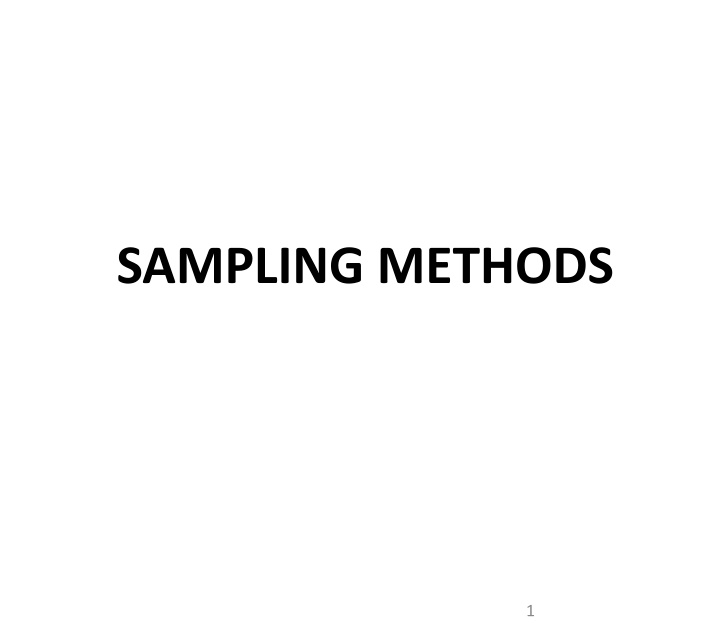
Sampling Methods: Importance and Process
Explore the concept of sampling methods, why sampling is essential, factors influencing sample representativeness, and the sampling process stages. Learn about defining populations, sampling frames, and more.
Download Presentation

Please find below an Image/Link to download the presentation.
The content on the website is provided AS IS for your information and personal use only. It may not be sold, licensed, or shared on other websites without obtaining consent from the author. If you encounter any issues during the download, it is possible that the publisher has removed the file from their server.
You are allowed to download the files provided on this website for personal or commercial use, subject to the condition that they are used lawfully. All files are the property of their respective owners.
The content on the website is provided AS IS for your information and personal use only. It may not be sold, licensed, or shared on other websites without obtaining consent from the author.
E N D
Presentation Transcript
SAMPLING A sample is a smaller (but hopefully representative) collection of units from a population used to determine truths about that population (Field, 2005) Why sample? Resources (time, money) and workload Gives results with known accuracy that can be calculated mathematically The sampling frame is the list from which the potential respondents are drawn Registrar s office Class rosters Must assess sampling frame errors 2
SAMPLING What is your population of interest? To whom do you want to generalize your results? All doctors School children All Bangladeshi People Women aged 15-45 years Other Can you sample the entire population? 3
SAMPLING. Three factors that influence sample representativeness Sampling procedure Sample size Participation (response) When might you sample the entire population? When your population is very small When you have extensive resources When you don t expect a very high response 4
5 SAMPLING BREAKDOWN
SAMPLING. STUDY POPULATION SAMPLE TARGET POPULATION 6
Sampling Process The sampling process comprises several stages: Defining the population of concern Specifying a sampling frame, a set of items or events possible to measure Specifying a sampling method for selecting items or events from the frame Determining the sample size Implementing the sampling plan Sampling and data collecting Reviewing the sampling process 7
Population definition A population can be defined as including all people or items with the characteristic one wishes to understand. Because there is very rarely enough time or money to gather information from everyone or everything in a population, the goal becomes finding a representative sample (or subset) of that population. 8
SAMPLING FRAME We seek a sampling frame which has the property that we can identify every single element and include any in our sample . The sampling frame must be representative of the population TYPES OF SAMPLING Probability (Random) Samples Non-Probability Samples 9
PROBABILITY SAMPLING A probability sampling scheme is one in which every unit in the population has a chance (greater than zero) of being selected in the sample, and this probability can be accurately determined. When every element in the population does have the same probability of selection, this is known as an 'equal probability of selection' (EPS) design. Such designs are also referred to as 'self-weighting' because all sampled units are given the same weight. 10
PROBABILITY SAMPLING. Types of Probability sampling: Simple Random Sampling, Systematic Sampling, Stratified Random Sampling, Cluster Sampling Multistage Sampling. Multiphase sampling 11
SIMPLE RANDOM SAMPLING.. Estimates are easy to calculate. Simple random sampling is always an EPS design, but not all EPS designs are simple random sampling. Disadvantages If sampling frame large, this method impracticable. Minority subgroups of interest in population may not be present in sample in sufficient numbers for study. 12
REPLACEMENT OF SELECTED UNITS Sampling schemes may be without replacement ('WOR' - no element can be selected more than once in the same sample) or with replacement ('WR' - an element may appear multiple times in the one sample). For example, if we catch fish, measure them, and immediately return them to the water before continuing with the sample, this is a WR design, because we might end up catching and measuring the same fish more than once. However, if we do not return the fish to the water (e.g. if we eat the fish), this becomes a WOR design. 13
SYSTEMATIC SAMPLING Systematic sampling relies on arranging the target population according to some ordering scheme and then selecting elements at regular intervals through that ordered list. Systematic sampling involves a random start and then proceeds with the selection of every kth element from then onwards. In this case, k=(population size/sample size). It is important that the starting point is not automatically the first in the list, but is instead randomly chosen from within the first to the kth element in the list. A simple example would be to select every 10th name from the telephone directory (an 'every 10th' sample, also referred to as 'sampling with a skip of 10'). 14
SYSTEMATIC SAMPLING As described above, systematic sampling is an EPS method, because all elements have the same probability of selection (in the example given, one in ten). It is not 'simple random sampling' because different subsets of the same size have different selection probabilities - e.g. the set {4,14,24,...,994} has a one-in-ten probability of selection, but the set {4,13,24,34,...} has zero probability of selection. 15
SYSTEMATIC SAMPLING ADVANTAGES: Sample easy to select Suitable sampling frame can be identified easily Sample evenly spread over entire reference population DISADVANTAGES: Sample may be biased if hidden periodicity in population coincides with that of selection. Difficult to assess precision of estimate from one survey. 16
STRATIFIED SAMPLING Where population embraces a number of distinct categories, the frame can be organized into separate "strata." Each stratum is then sampled as an independent sub-population, out of which individual elements can be randomly selected. Every unit in a stratum has same chance of being selected. Using same sampling fraction for all strata ensures proportionate representation in the sample. Adequate representation of minority subgroups of interest can be ensured by stratification & varying sampling fraction between strata as required. 17
STRATIFIED SAMPLING Finally, since each stratum is treated as an independent population, different sampling approaches can be applied to different strata. Drawbacks to using stratified sampling. First, sampling frame of entire population has to be prepared separately for each stratum Second, when examining multiple criteria, stratifying variables may be related to some, but not to others, further complicating the design, and potentially reducing the utility of the strata. Finally, in some cases (such as designs with a large number of strata, or those with a specified minimum sample size per group), stratified sampling can potentially require a larger sample than would other methods 18
STRATIFIED SAMPLING. Draw a sample from each stratum 19
CLUSTER SAMPLING Cluster sampling is an example of 'two-stage sampling' . First stage a sample of areas is chosen; Second stage a sample of respondents within those areas is selected. Population divided into clusters of homogeneous units, usually based on geographical contiguity. Sampling units are groups rather than individuals. A sample of such clusters is then selected. All units from the selected clusters are studied. 20
CLUSTER SAMPLING. Advantages : Cuts down on the cost of preparing a sampling frame. This can reduce travel and other administrative costs. Disadvantages: sampling error is higher for a simple random sample of same size. Often used to evaluate vaccination coverage in EPI 21
CLUSTER SAMPLING. Identification of clusters List all cities, towns, villages & wards of cities with their population falling in target area under study. Calculate cumulative population & divide by 30, this gives sampling interval. Select a random no. less than or equal to sampling interval having same no. of digits. This forms 1st cluster. Random no.+ sampling interval = population of 2nd cluster. Second cluster + sampling interval = 4th cluster. Last or 30th cluster = 29th cluster + sampling interval 22
MULTISTAGE SAMPLING Complex form of cluster sampling in which two or more levels of units are embedded one in the other. First stage, random number of districts chosen in all states. Followed by random number of talukas, villages. Then third stage units will be houses. All ultimate units (houses, for instance) selected at last step are surveyed. 23
MULTISTAGE SAMPLING.. This technique, is essentially the process of taking random samples of preceding random samples. Not as effective as true random sampling, but probably solves more of the problems inherent to random sampling. An effective strategy because it banks on multiple randomizations. As such, extremely useful. Multistage sampling used frequently when a complete list of all members of the population not exists and is inappropriate. Moreover, by avoiding the use of all sample units in all selected clusters, multistage sampling avoids the large, and perhaps unnecessary, costs associated with traditional cluster sampling. 24
MULTI PHASE SAMPLING Part of the information collected from whole sample & part from subsample. In Tb survey MT in all cases Phase I X Ray chest in MT +ve cases Phase II Sputum examination in X Ray +ve cases - Phase III Survey by such procedure is less costly, less laborious & more purposeful 25
MATCHED RANDOM SAMPLING A method of assigning participants to groups in which pairs of participants are first matched on some characteristic and then individually assigned randomly to groups. The Procedure for Matched random sampling can be briefed with the following contexts, Two samples in which the members are clearly paired, or are matched explicitly by the researcher. For example, IQ measurements or pairs of identical twins. Those samples in which the same attribute, or variable, is measured twice on each subject, under different circumstances. Commonly called repeated measures. Examples include the times of a group of athletes for 1500m before and after a week of special training; the milk yields of cows before and after being fed a particular diet. 26
NON PROBABILITY SAMPLING Any sampling method where some elements of population have no chance of selection (these are sometimes referred to as 'out of coverage'/'undercovered'), or where the probability of selection can't be accurately determined. It involves the selection of elements based on assumptions regarding the population of interest, which forms the criteria for selection. Hence, because the selection of elements is nonrandom, nonprobability sampling not allows the estimation of sampling errors.. 27
NONPROBABILITY SAMPLING. Nonprobability Sampling includes: Accidental Sampling, Quota Sampling and Purposive Sampling. 28
QUOTA SAMPLING The population is first segmented into mutually exclusive sub-groups, just as in stratified sampling. Then judgment used to select subjects or units from each segment based on a specified proportion. For example, an interviewer may be told to sample 200 females and 300 males between the age of 45 and 60. It is this second step which makes the technique one of non-probability sampling. In quota sampling the selection of the sample is non- random. For example interviewers might be tempted to interview those who look most helpful. The problem is that these samples may be biased because not everyone gets a chance of selection. This random element is its greatest weakness and quota versus probability has been a matter of controversy for many years 29
CONVENIENCE SAMPLING Sometimes known as grab or opportunity sampling or accidental or haphazard sampling. A type of nonprobability sampling which involves the sample being drawn from that part of the population which is close to hand. That is, readily available and convenient. The researcher using such a sample cannot scientifically make generalizations about the total population from this sample because it would not be representative enough. For example, if the interviewer was to conduct a survey at a shopping center early in the morning on a given day, the people that he/she could interview would be limited to those given there at that given time, which would not represent the views of other members of society in such an area, if the survey was to be conducted at different times of day and several times per week. This type of sampling is most useful for pilot testing. In social science research, snowball sampling is a similar technique, where existing study subjects are used to recruit more subjects into the sample. 30
CONVENIENCE SAMPLING. Use results that are easy to get 31 31
Judgmental sampling or Purposive sampling - The researcher chooses the sample based on who they think would be appropriate for the study. This is used primarily when there is a limited number of people that have expertise in the area being researched 32

